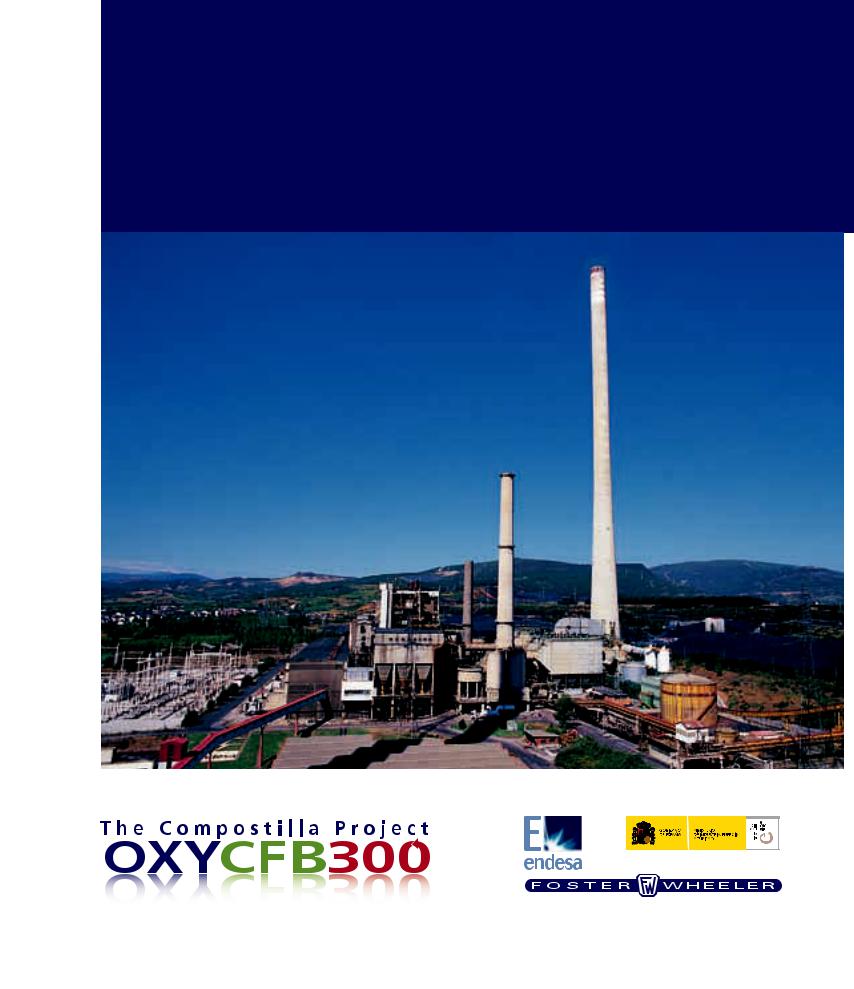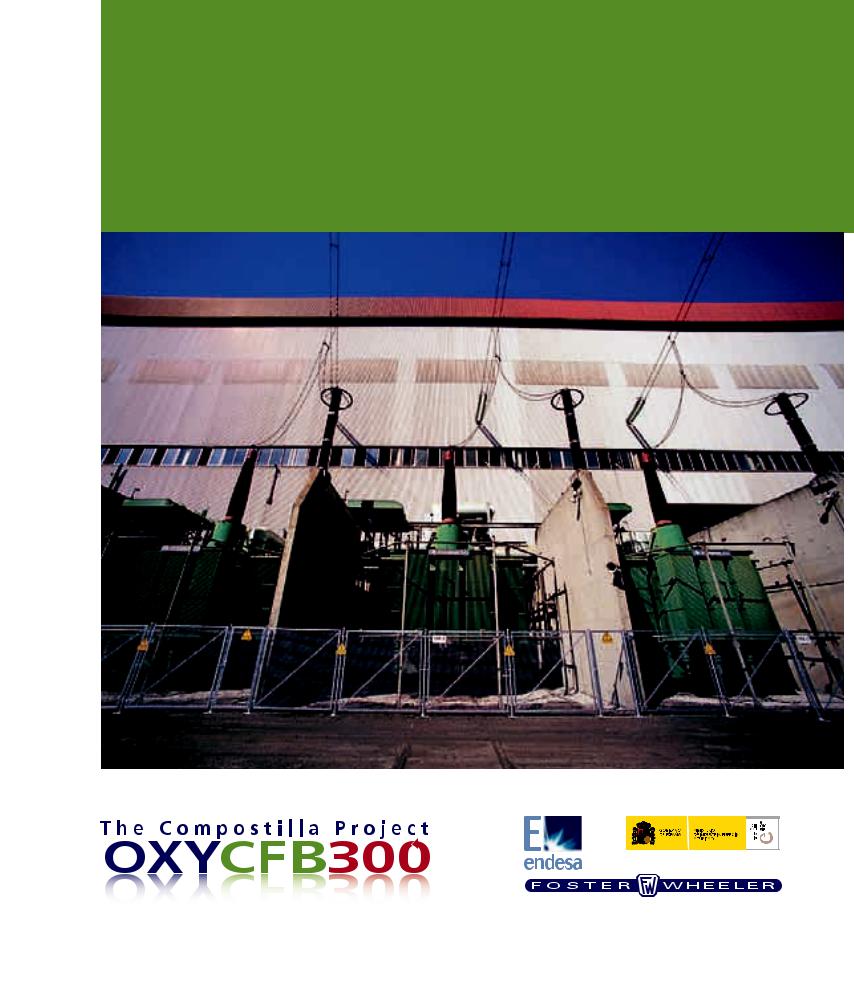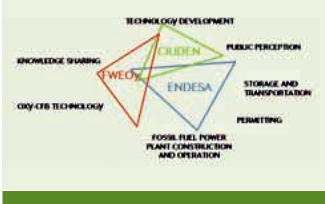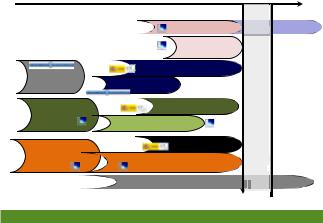
01 POWER ISLAND / 04 CO2 capture / Compostilla-project-OXYCFB300-FEED-report
.pdf
Access to and use of the information ¡n this document ¡s subject to the terms of the important notice at the front of the document

1
Executive Summary
OXYCFB300 FEED
Final Conclusions

22 | |
OXYCFB300 COMPOSTILLA. CARBON CAPTURE AND STORAGE DEMOSTRATION PROYECT |
Index |
|
|
1.1 |
Introduction . . . . . . . . . . . . . . . . . . . . . . . . . . . . . . . . . . . . . . . . . . . . . . . . . . . . . . . . . . . . . . . . . . . . . . . . . . . |
23 |
|
1.1.1 EU CCS Demonstration Programme . . . . . . . . . . . . . . . . . . . . . . . . . . . . . . . . . . . . . . . |
23 |
|
1.1.2 Technology Development Stage: FEED Objectives . . . . . . . . . . . . . . . . . . . . . |
23 |
1.2 |
FEED Study . . . . . . . . . . . . . . . . . . . . . . . . . . . . . . . . . . . . . . . . . . . . . . . . . . . . . . . . . . . . . . . . . . . . . . . . . . . . |
23 |
CHAPTER 1. EXECUTIVE SUMMARY |
| 23 |
1.1 INTRODUCTION
1.1.1 EU CCS Demonstration Programme
CO2 Capture and Storage (CCS) is recognised as a critical technology for combating climate change within a portfolio of technologies, including greater energy efficiency and renewable energy.
The EU, which is responsible for around 11% of global GHG emissions today, has put in place binding legislation to reduce its emissions to 20% below 1990 levels by 2020. For the longer term, the EU has committed to cut its emissions to 80-95% below 1990 levels by 2050, as part of the action that will be required from the developed world.
The EU adopted in 2009 its CCS Directive as part of a package of climate and energy measures, establishing a legal framework for CO2 storage and EU funding for up to 12 CCS demonstration projects – supported by the launch of the European CCS Demonstration Project Network and European Industrial Initiative on CCS.
The EU agreed to set aside 300 million emission unit allowances (EUAs) from the New Entrance Reserve (NER 300) to demonstrate CCS and innovative renewable energy technologies. The EU also launched an EU Energy Programme for Recovery (EEPR) in which €1 billion was set aside for CCS demonstration projects in Poland, Germany, the Netherlands, Spain, Italy and the UK.
The OXYCFB300 Project applied to EEPR program in July 2009 and the EC communicated in October 2009 that the Project was awarded. In May 2010 the Project partners (ENDESA, CIUDEN and FOSTER WHEELER) signed a Grant Agreement with the EC, establishing the scope of the Project and the conditions of the award, and also a Description of the Work (Annex I GA, DoW) was agreed between the beneficiaries.
1.1.2 Technology Development Stage: FEED Objectives
The OXYCFB300 Compostilla Project is a Carbon Capture and Storage (CCS) integral commercial demonstration project, including CO2 capture, transport and storage.
The Project is based on a 300 MWe Circulating Fluidised Bed (CFB) supercritical oxycombustion plant, with CO2 storage in a deep saline formation. This technology will be tested first on a new 30 MWth Technology Development Plant (TDP) sited in Cubillos del Sil, close to ENDESA’s Compostilla Power Station in the Northwest of Spain, in which it will be scaled to demonstration size (300 MWe).
The Project has been divided into two distinct phases to significantly reduce the economic and technical risks of this cutting edge CCS demonstration Project:
Phase I. Technological Development (2009-2013)
Phase II. Construction of the Demo Project infrastructure (2013-
1.2 FEED STUDY
As established in DoW Task 1.7, a Front-End Engineering Design (FEED) study ought to be carried out based on the preliminary feasibility Project studies.
The aims of the FEED work include:
Analysis of state-of-the-art in CCS technologies, in the three areas: capture (oxyfuel technology in CFB boiler, air separation equipment and CO2 purification and compression), transport (singular transport studies of anthropogenic CO2 ) and injection and storage of CO2.
Performing of feasibility studies and analysis of the available design options.
Overall analysis of the project issues, identification of the main needs, environmental constraints, legal requirements, identification of dependencies and integration of the three areas.
Once technologies and major equipment have been selected, the corresponding FEEDs have been developed detailed enough to obtain an economic estimate.
Development of the documentation for permit applications and analysis of operational risks. Integral Risks Assessment supports Final Investment Decision (FID) of Phase II.
Preparation of technical specifications to obtain quotations and carrying out the OXYCFB300 commercial demonstration plant budget with a deviation of 10%.
FEED engineering has been developed by ENDESA in collaboration with its partners in the project, based on their knowledge as power generation company and feasibility studies prior EEPR that were conducted with FOSTER WHEELER for Compostilla Project OXYCFB300.
FEED starting point was June 2010 and it was performed during 36 months.
This document summarizes all the engineering studies and considerations developed during the Project FEED. From the original conceptual idea, FEED engineering works have yielded a functional and technically feasible power plant, which successfully integrates oxycombustion technology with a state-of-the-art ultrasupercritical regenerative power cycle and with an innovative CO2 purification and compression process, integrated with a transport line that conducts the CO2 at dense phase to the final CO2 geologic sequestration site, for an operational life of 25 years.
2016)

Access to and use of the information ¡n this document ¡s subject to the terms of the important notice at the front of the document

2
OXYCFB300 Framework
OXYCFB300 FEED
Final Conclusions

26 | |
OXYCFB300 COMPOSTILLA. CARBON CAPTURE AND STORAGE DEMOSTRATION PROJECT |
Index
2.1 Project Overview . . . . . . . . . . . . . . . . . . . . . . . . . . . . . . . . . . . . . . . . . . . . . . . . . . . . . . . . . . . . . . . 27
2.2 OXYCFB300 Schedule. . . . . . . . . . . . . . . . . . . . . . . . . . . . . . . . . . . . . . . . . . . . . . . . . . . . . . . . . . 29
2.3 Project Organizaron . . . . . . . . . . . . . . . . . . . . . . . . . . . . . . . . . . . . . . . . . . . . . . . . . . . . . . . . . . . . 30
2.3.1 Action Detailed. . . . . . . . . . . . . . . . . . . . . . . . . . . . . . . . . . . . . . . . . . . . . . . . . . . . . . . . . . . 30
2.3.2 Action Implementation . . . . . . . . . . . . . . . . . . . . . . . . . . . . . . . . . . . . . . . . . . . . . . . . . . . 30
List of Figures
Figure 2.1 Location of the capture site of the OXYCFB300 Compostilla Project . . . . . . . . . |
27 |
Figure 2.2 Role of partners. . . . . . . . . . . . . . . . . . . . . . . . . . . . . . . . . . . . . . . . . . . . . . . . . . . . . . . . . 28
Figure 2.3 Action strategy . . . . . . . . . . . . . . . . . . . . . . . . . . . . . . . . . . . . . . . . . . . . . . . . . . . . . . . . . 29
Figure 2.4 Management structure . . . . . . . . . . . . . . . . . . . . . . . . . . . . . . . . . . . . . . . . . . . . . . . . . . 30

CHAPTER 2. OXYCFB300 FRAMEWORK
2.1 PROJECT OVERVIEW
The OXYCFB300 Compostilla Project Basis
ENDESA Generación, under its power generation strategy and continuing with the conviction to remain a leader in innovation and to tackle climate change decided to promote a CCS integral Commercial Demonstration Project, including CO2 capture, transport and storage, based on a circa 340 MWe gross Circulating Fluidised Bed (CFB) supercritical oxy combustion plant, with CO2 storage in a saline aquifer. The main target of this Demo project is to validate, at commercial plant size, a CO2 Capture and Storage (CCS) technology that will allow the renovation of the existing fossil thermal plants from 2020, using a wide range of domestic coals, as well as imported fuels (coals, pet coke), and biomass. The foreseen plant´s location is ENDESA`s Compostilla Power Plant, in the northwest of Spain.
Figure 2.1 Location of the capture site of the OXYCFB300 Compostilla Project
To guarantee the success of the project, ENDESA signed cooperation agreements with FOSTER WHEELER ENERGIA SL (FWES) and CIUDEN to participate in the scale-up validation program as well as for the future construction of the Commercial Demo Plant. FWES and ENDESA GENERACIÓN signed on October 2007 an agreement for joint development of the OXY-CFB with indigenous coals, including all the validation steps. A feasibility study of the future OXY-CFB demo powerplant was carried out during 2008. In this proposal the technology provider is the Finland based FOSTER WHEELER ENERGIA Oy, that is the responsible of the basic design of CFB units within the FOSTER WHEELER Global Power Group.
In October 2009, the project (ENDESA, CIUDEN, FWEOy) was awarded by the European Commission (EC) under the EEPR (European Energy Program for Recovery) Program with a contribu-
| 27
tion of a maximum of 180 M€, equivalent to the 80% of the total eligible costs estimated for the Phase-I of the project. The overall project schedule was divided in two phases: Phase I-Technology Development (2009-2013) (hereinafter, the “Action”), and Phase II-Construction of the Demo Project Infrastructure including capture transport and storage concepts (20132016) (the Phase IIConstruction of the Demo Project Infrastructure). The activities included in the EEPR Action are to be carried out during Phase I- Technology Development. By March of 2013, the Final Investment Decision (FID) process of the integrated project has been started and the FID is expected by the end of 2013.
A key role in this development has been assumed by CIUDEN who constructed an Integrated CCS Technology Development Plant (TDP) with EEPR funds in Compostilla featuring a 30MWth Oxy-Circulating Fluid Bed (Oxy-CFB) using the same technology to be incorporated by the commercial scale demo plant (Demo Plant). In that regard, CIUDEN made an agreement with FOSTER WHEELER ENERGÍA, S.L. (“FWES”), company of Foster Wheeler Global Power Group, for the supply by FWES of an OxyCFB boiler for the TDP.
In parallel with these capture activities, ENDESA started different geological surveys for a possible CO2 storage site in the vicinity of Compostilla (Duero Site). To reduce the risks of the project associated with the storage site, and as a second alternative, ENDESA also worked in another area close to Teruel Power Plant (Andorra Site), where it was carried out the geological characterization of an alternative saline aquifer. The studies developed revealed that Teruel geological structure is not technically nor economically feasible to withstand a CO2 reservoir in the size needed for the Project or for any other commercial application of CO2 storage for large scale powerplants.
EEPR (European Energy Programme for Recovery)
The European Energy Programme for Recovery (EEPR) provides financial support to selected highly strategic projects in the energy sector. By co-financing these projects, the programme helps the European Union to progress towards its energy and climate policy objectives: security and diversification of energy supply; completion and smooth operation of the internal energy market; and reduction of greenhouse gas emissions. At the same time, by sustaining capital expenditure in the real economy, the programme aims at stimulating economic activity and promoting growth and job creation.
The EEPR was set up in the wider context of the global effort undertaken at EU level to face the financial crisis that erupted in 2008 and to stimulate economic recovery. Since then, an even more severe crisis is sweeping Europe and therefore policies to stimulate recovery remain highly necessary. Given the complexity and the magnitude of the crisis, no single policy initiative or spending programme can be expected to deliver economic recov-

28 | |
OXYCFB300 COMPOSTILLA. CARBON CAPTURE AND STORAGE DEMOSTRATION PROJECT |
ery on its own. However, in this difficult context, the EEPR has been and continues to be a useful tool that allows progress in a number of key investment projects, which without public EU funding would be at risk of being delayed, downsized or cancelled.
The OXYCFB300 Project applied to EEPR Program in July 2009. In October 2009 EC communicated to the OXYCFB300 Project that it was awarded and finally, in May 2010 the three partners signed a Grant Agreement (GA) with the EC which established the scope of the OXYCFB300 Project and conditions of the award. One of the requirements of EC to sign the GA was the signing of a DoW (Description of Work) between the partners involved. This DoW included the scope of the Action and described the activities to be developed by each partner.
Within the general framework of the EEPR, the CCS programme makes a significant contribution to the general objective of European energy policy to deliver secure, competitive and sustainable energy supplies.
Investing in CCS technologies at such an early stage of their development offers the EU the opportunity to be a global leader in CCS commercialization. CCS also offers the potential to help considerably in meeting our sustainable energy targets for 2020 and beyond.
CCS projects supported by the EEPR aim to:
Help demonstrate the entire CCS-value chain technology by 2015;
Contribute to lowering the manufacturing and operational costs in the second generation technology;
Accelerate the development and implementation of regulatory and permitting schemes.
OXYCFB300 Compostilla Project EEPR Beneficiarles
ENDESA, part of the Italian group Enel, is the leading Spanish electric utility and the largest private electricity multinational in Latin America holding a strong position in other energy sectors such as coal mining, gas, cogeneration and renewable energies. ENDESA Generacion has a long tradition in producing electricity from coal, and has been working very actively on Clean Coal Technologies (CCT) and CO2 Capture and Storage (CCS) over the last six years.
CIUDEN is a technological development institution created in 2006 by the Spanish Administration. CIUDEN’s main objectives are the research, development and demonstration of efficient, cost effective and reliable advanced CCT and CCS technologies. CIUDEN aims to support and promote international cooperation so as to enhance European competitiveness through strategic research partnerships with industry, SMEs, Universities and research institutions.
Foster Wheeler Energia Oy (FWEOy) is a Finland based operating company of Foster Wheeler AG (FWAG) well known at international level for its energy production systems based on the Circulating Fluidised Bed technology (CFB).
Figure 2. 2 Role of partners

CHAPTER 2. OXYCFB300 FRAMEWORK |
| 29 |
2.2 OXYCFB300 SCHEDULE
Initially, the OXYCFB300 Compostilla project EEPR Action had an estimated duration of 42 months (mid 2009-2013), but in November 2012 EC extended the duration until October 2013 due to the delays caused in TDP tests and in storage programmed activities.
Construction of a Technological Development Plant (TDP) in the CIUDEN facilities and perform tests in CIUDEN pilot plant, with improvement of the knowledge of CO2 transport performance based on longterm experimental tests with real CO2 streams produced by the TDP. Economic and Risk Assessment studies.
Development of a Front-End Engineering Design (FEED) for the demo plant.
To reduce the risks associated with any new technology, the strategy of the Beneficiaries has been to complete under the EEPR Action, the Phase I-Technology Development. This period allows filling the knowledge gaps in the three technical areas and consolidating a more reliable integrated concept.
The strategy followed is schemed in the picture below:
|
2009 |
2010 |
2011 |
2012 |
03/2013 10/2013 |
|
|||||||||||
|
|
TECHNOLOGY DEVELOPMENT |
|
|
|
|
|
|
|
|
|
|
|
||||
|
|
|
|
|
|
|
|
|
|
|
|
|
|
|
|
|
|
CAPTURE |
|
|
|
|
|
FEED |
|
|
|
FINA |
L |
REPORT |
|
||||
|
CANMET |
|
|
|
|
|
|
|
DECISION |
|
|
||||||
|
|
CIUDEN OXY 30M Wth |
|
|
|
|
|
|
|
||||||||
|
|
PHASE I |
ECON & RISK |
|
|
|
|
|
|
|
|
|
|
|
|||
|
|
ASSESS. STUDIES |
|
|
|
|
|
|
|
|
|
|
|||||
|
TRANSPORT |
1MWth |
|
REF. PLANT TESTS |
|
|
|
|
|
|
|
INVESTMENTFINAL |
|
|
|||
|
PRELIMINARY |
CIUDENT DP&TESTS |
|
|
|
|
|
|
|
||||||||
|
|
|
|
|
|
|
|
|
|
|
|
||||||
|
|
|
|
|
|
|
|
|
|
|
|
|
|
|
|
||
|
|
STUDIES |
|
SINGULAR STUDIES |
|
|
|
|
|
|
|
|
|
|
|
||
STORAGE |
|
|
|
|
|
|
|
|
|
|
|
|
|
|
|
|
|
|
PRELIMINARY |
|
EXTENSIVE |
|
CIUDEN TDP |
|
|
|
|
|
|
|
|
|
|
|
|
|
|
CHARACTERIZATION |
SUBSURFACE |
|
|
|
|
|
SITE |
|
CONSTRUCTION |
|
|||||
|
|
|
|
|
|
|
|
|
|
|
|
|
|||||
|
|
|
|
CHARACTERIZATION |
|
|
|
|
|
|
MO |
|
NITORING |
|
|||
|
K.S |
|
|
KNOWLEDGE SHARI |
|
|
|
NG |
|
|
|
|
|||||
|
|
|
|
|
|
|
|
||||||||||
|
|
|
|
|
|
|
|
|
|
|
|
|
|
|
|
|
|
Figure 2. 3 Action strategy
Storage
The storage area includes the complete characterization of the site and evaluation as a feasible CO2 storage site. Tasks include the following items:
Sites Assessment, including the development of a homogeneous three-dimensional static geological earth model based on the data collected in previous steps.
Preliminary Characterization of the subsurface structures,through a magnetoteluric campaign, 2D seismic survey, well and drilling, and logging campaign. Update and upgrade geological models.
Extensive subsurface characterization, through new drilling of wells, logging campaign and 3-D seismic survey that will provide the necessary information to feed a three-dimensional model and finish the characterization of the site.
Economic and Risk Assessment studies.
Monitoring and risk management. Definition and assessment of risks for defining monitoring program.
Identification and characterization of a Pilot Plant for long-term storage of CO2.
Development of algorithms that allow the simulation of the processes that will take place within the reservoir and in the seal during the storage process.
The activities in the Action Work Plan by area have been:
Capture
Characterization of the design fuels and limestone in air and oxy-fuel conditions in a lab-scale plant of around 1MWt at CANMET in Canada. Construction of a Technological Development Plant (TDP) in the CIUDEN facilities and perform validation tests at CIUDEN oxy-cir- culating fluidized bed boiler 1:30 scale.
Develop a test program in the air reference plant (Lagisza CFB). Development of operating modes and control strategies of the fully integrated Technology Development Plant.
Develop models for optimising the final design for oxy-combustion. Economic and Risk Assessment studies.
Development of a Front-End Engineering Design (FEED) for the demo plant.
Some of these activities are partially covered and funded by the FP7 project “FLEXI-BURN CFB”.
Transport
Preliminary studies.
Singular studies that will cover research gaps regarding CO2 transportation for OXY-CFB-300 composition and operating conditions.
In parallel, two very important interrelated activities were begun: Permitting process: To avoid delays in the construction phase, different permitting processes must proceed according to the general schedule presented in point 1.2.3. (Fig. 1).
Public acceptance and communication planning. To guarantee the success of the proposal, communication planning was launched from the very first stages of the Action.
By March and economical boundary conditions of the project. By By March 2013 the Final Investment Decision (FID) process of the integrated project was started, based on all the knowledge and results obtained in the Phase I-Technology Development and the final permitting, financial and economical boundary conditions of the project. By that date the three areas, capture, transport and storage, had converged with positive results. Additionally all the CCS regulatory boundaries must be established and confirmed by the relevant regulatory bodies. The FID will be completed by the end of the Action (foreseen October 2013).
If the FID is positive, the Phase II of the Project will be executed. The duration of the construction of all infrastructures of the Project (Phase II) is estimated in 56 months.
